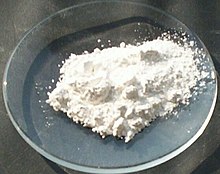ചുണ്ണാമ്പ്
ദൃശ്യരൂപം

| |
| Names | |
|---|---|
| IUPAC name
Calcium hydroxide
| |
Other names
| |
| Identifiers | |
3D model (JSmol)
|
|
| ChEBI | |
| ChemSpider | |
| ECHA InfoCard | 100.013.762 |
| EC Number |
|
| E number | E526 (acidity regulators, ...) |
| Gmelin Reference | 846915 |
| KEGG | |
PubChem CID
|
|
| RTECS number |
|
| UNII | |
CompTox Dashboard (EPA)
|
|
| InChI | |
| SMILES | |
| Properties | |
| Ca(OH)2 | |
| Molar mass | 74.093 g/mol |
| Appearance | White powder |
| Odor | Odorless |
| സാന്ദ്രത | 2.211 g/cm3, solid |
| ദ്രവണാങ്കം | |
| |
Solubility product (Ksp)
|
5.5×10−6 |
| Solubility | |
| Basicity (pKb) | 1.37 (first OH−), 2.43 (second OH−)[1][2] |
| −22.0·10−6 cm3/mol | |
Refractive index (nD)
|
1.574 |
| Structure | |
| Hexagonal, hP3[3] | |
| P3m1 No. 164 | |
a = 0.35853 nm, c = 0.4895 nm
| |
| Thermochemistry | |
Std molar
entropy (S⦵298) |
83 J·mol−1·K−1[4] |
Std enthalpy of
formation (ΔfH⦵298) |
−987 kJ·mol−1[4] |
| Hazards | |
| NFPA 704 (fire diamond) | |
| Flash point | Non-flammable |
| Lethal dose or concentration (LD, LC): | |
LD50 (median dose)
|
7340 mg/kg (oral, rat) 7300 mg/kg (mouse) |
| NIOSH (US health exposure limits): | |
PEL (Permissible)
|
TWA 15 mg/m3 (total) 5 mg/m3 (resp.)[6] |
REL (Recommended)
|
TWA 5 mg/m3[6] |
IDLH (Immediate danger)
|
N.D.[6] |
| Safety data sheet (SDS) | [5] |
| Related compounds | |
| Other cations | Magnesium hydroxide Strontium hydroxide Barium hydroxide |
Except where otherwise noted, data are given for materials in their standard state (at 25 °C [77 °F], 100 kPa).
| |
Ca(OH)2 എന്ന രാസവാക്യമുള്ള ക്ഷാരസ്വഭാവമുള്ള ഒരു അജൈവസംയുക്തമാണ് കാൽസ്യം ഹൈഡ്രോക്സൈഡ് അഥവാ ചുണ്ണാമ്പ്. നിറമില്ലാത്ത ക്രിസ്റ്റൽ രൂപത്തിലോ വെളുത്ത പൊടിരൂപത്തിലോ കാണപ്പെടുന്ന ഈ സംയുക്തം കാൽസ്യം ഓക്സൈഡ് ജലവുമായി യോജിപ്പിക്കുമ്പോൾ ആണ് ഉണ്ടാവുന്നത്. ധാരാളം ഉപയോഗങ്ങൾ ഉള്ള ഈ പദാർത്ഥം ഭക്ഷ്യമേഖലയിൽ ഉപയോഗിക്കുമ്പോൾ ഇതിന്റെ ഇ നമ്പർ E526 ആണ്.
കക്കയുടെ തോട് നീറ്റിയെടുക്കുന്ന കാൽസ്യം ഓക്സൈഡിനെ (CaO)(നീറ്റുകക്ക) ജലവുമായിച്ചേർത്താണ് ചുണ്ണാമ്പ് സാധാരണ നിർമ്മിക്കുന്നത്. കൃഷിയ്ക്കും മറ്റ് വ്യാവസായിക ആവശ്യങ്ങൾക്കും ചുണ്ണാമ്പ് ഉപയോഗപ്പെടുത്താറുണ്ട്. വെറ്റില മുറുക്കുന്നവർ വെറ്റിലയ്ക്കൊപ്പം ചുണ്ണാമ്പും ഉപയോഗിക്കാറുണ്ട്.
കാൽസ്യം ഹൈഡ്രോക്സൈഡ് (Calcium Hydroxide) ആണ് രാസനാമം.Ca(OH)2 എന്നതാണ് രാസവാക്യം
ചിത്രശാല
[തിരുത്തുക]-
കോഴിക്കോട് ജില്ലയിലെ രാമനാട്ടുകരയിലെ ഒരു സംസ്ക്കരണ യൂണിറ്റിൽ കക്ക നീറ്റി ചുണ്ണാമ്പ് നിർമ്മിച്ച് വിൽപ്പനയ്ക്ക് വെച്ചിരിക്കുന്നു.
-
കോഴിക്കോട് ജില്ലയിലെ രാമനാട്ടുകരയിലെ ഒരു സംസ്ക്കരണ യൂണിറ്റിൽ കക്ക നീറ്റി ചുണ്ണാമ്പ് നിർമ്മിച്ച് വിൽപ്പനയ്ക്ക് വെച്ചിരിക്കുന്നു.
-
കോഴിക്കോട് ജില്ലയിലെ രാമനാട്ടുകരയിലെ ഒരു സംസ്ക്കരണ യൂണിറ്റിൽ കക്ക നീറ്റി ചുണ്ണാമ്പ് നിർമ്മിക്കുന്നു.
-
കോഴിക്കോട് ജില്ലയിലെ രാമനാട്ടുകരയിലെ ഒരു സംസ്ക്കരണ യൂണിറ്റിൽ കക്ക നീറ്റി ചുണ്ണാമ്പ് നിർമ്മിച്ച് വിൽപ്പനയ്ക്ക് വെച്ചിരിക്കുന്നു.
-
കോഴിക്കോട് ജില്ലയിലെ രാമനാട്ടുകരയിലെ ഒരു സംസ്ക്കരണ യൂണിറ്റിൽ കക്ക നീറ്റി ചുണ്ണാമ്പ് നിർമ്മിച്ച് വിൽപ്പനയ്ക്ക് വെച്ചിരിക്കുന്നു.
അവലംബം
[തിരുത്തുക]- ↑ "Sortierte Liste: pKb-Werte, nach Ordnungszahl sortiert. – Das Periodensystem online".
- ↑ ChemBuddy dissociation constants pKa and pKb
- ↑ Petch, H. E. (1961). "The hydrogen positions in portlandite, Ca(OH)2, as indicated by the electron distribution". Acta Crystallographica. 14 (9): 950. doi:10.1107/S0365110X61002771.
- ↑ 4.0 4.1 Zumdahl, Steven S. (2009). Chemical Principles 6th Ed. Houghton Mifflin Company. p. A21. ISBN 0-618-94690-X.
- ↑ "MSDS Calcium hydroxide" (PDF). Archived from the original (PDF) on 25 മാർച്ച് 2012. Retrieved 21 ജൂൺ 2011.
- ↑ 6.0 6.1 6.2 NIOSH Pocket Guide to Chemical Hazards. "#0092". National Institute for Occupational Safety and Health (NIOSH).
.





